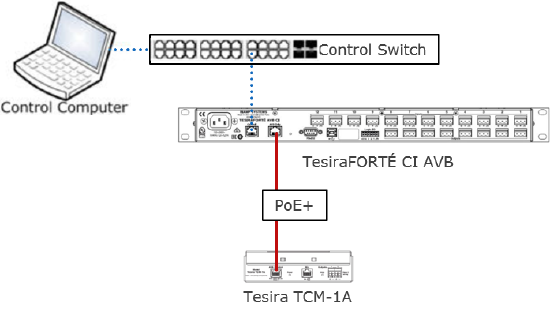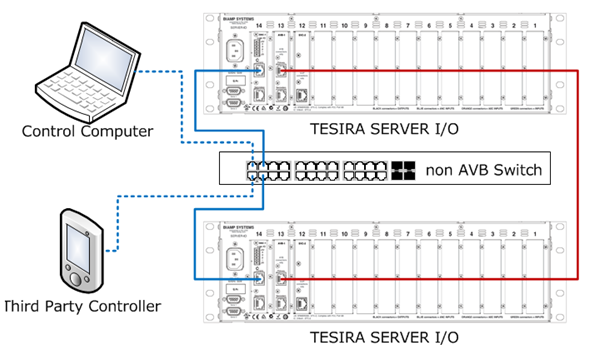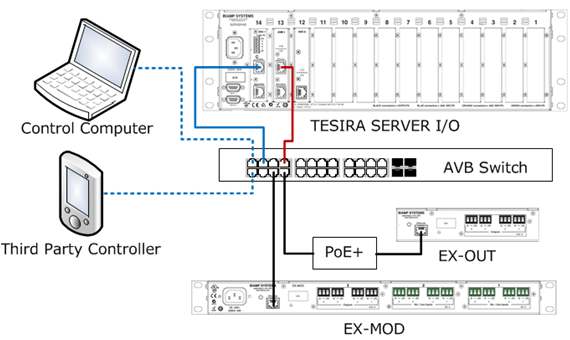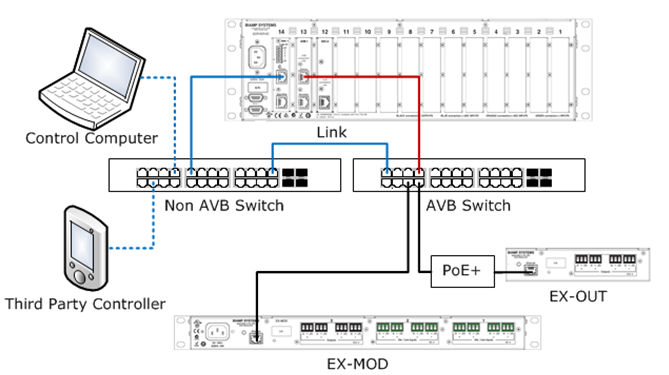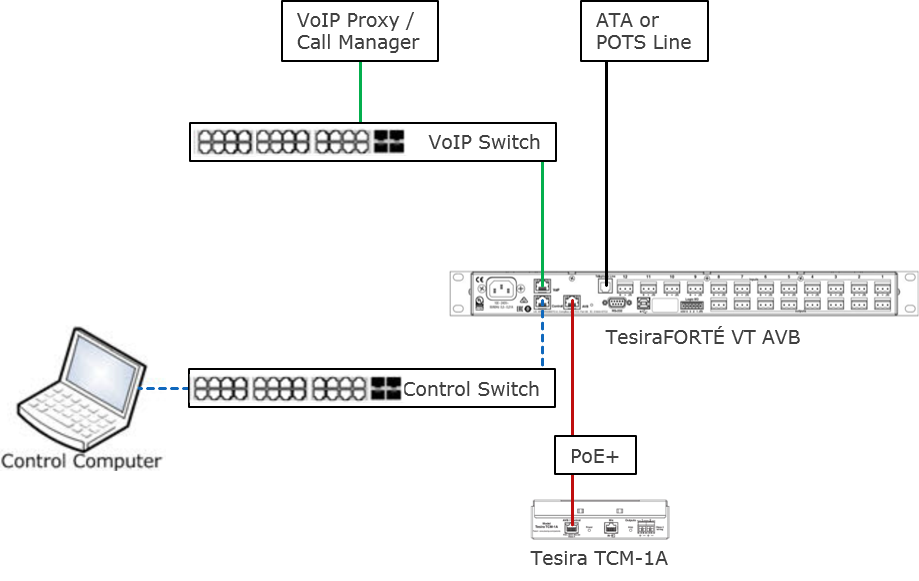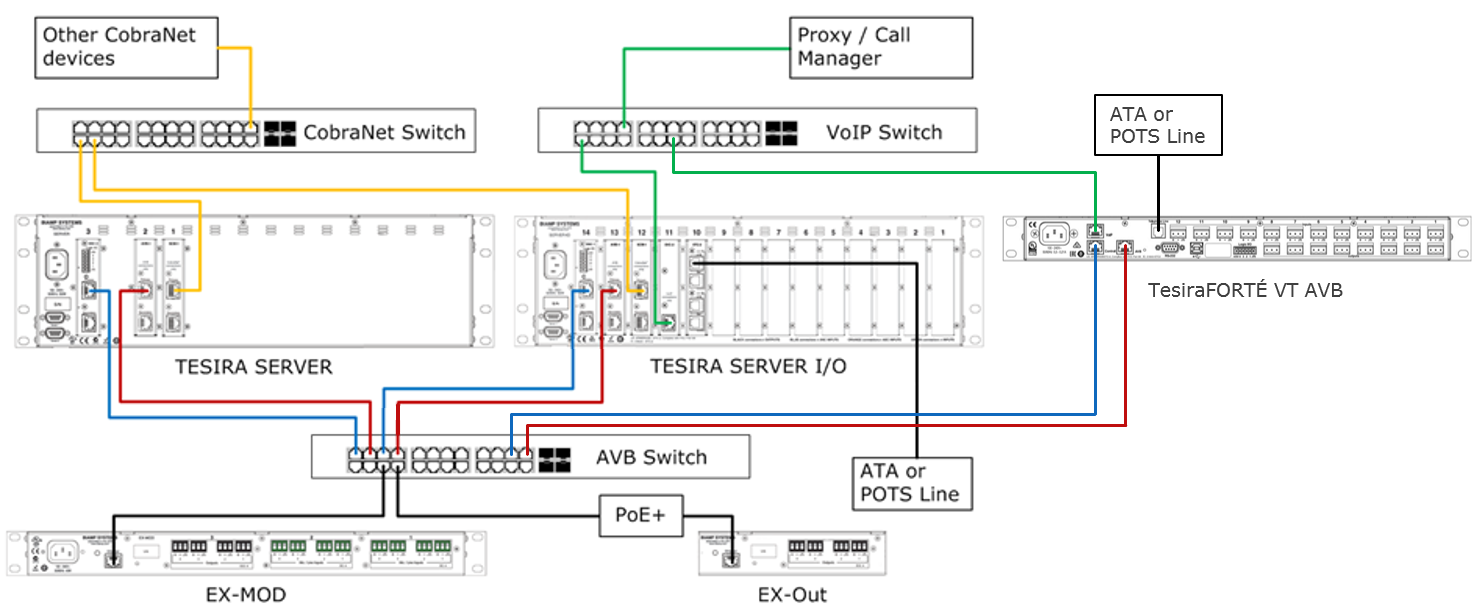Tesira Network Infrastructure
This article describes the supported network topologies required when interfacing Tesira Server-class devices and Expanders.
Tesira devices support the use of many Ethernet network-based features to facilitate integrating Audio and Video in an AV environment. Depending on the Tesira hardware, network port functions are separate or combined.
-
Tesira SERVER and SERVER-IO devices have dedicated control network and media network ports available on separate card modules.
-
TesiraFORTE AVB devices have dedicated control network and media network ports.
-
TesiraAMP devices have dedicated control network and AVB network ports.
-
Tesira Expanders use one Ethernet port and their control and AVB traffic is combined.
-
TesiraLUX devices have dedicated control network and AVB network ports. (Note: The 1G AVB and 10G SFP+ AVB ports cannot be active at the same time.)
Tesira devices are not meant to be connected directly to the internet. The expectation is that enterprise network security best-practices are followed to provide upstream firewalls and routers between Tesira network ports and external public-facing networks.
See Tesira security best practices for a guide on securely deploying a Tesira system.
Network Interface Overview
A Tesira system will support the following network interfaces:
-
Control Network Interface
-
Ethernet network used to relay configuration data between Server-class and Expander-class Tesira devices and connected control computers.
-
-
AVB (Audio-Video Bridging) Interface
-
Server and Expander-class devices are able to share audio using AVB capable bridges (switches).
-
Tesira SERVER and SERVER-IO devices require the use of the AVB-1 card.
-
Tesira audio Expanders, TesiraFORTÉ AVB varieties, TesiraAMP, and TesiraLUX devices support AVB functionality natively.
-
-
CobraNet Interface
-
Tesira SERVER or SERVER-IO devices using SCM-1 cards are able to share 32x32 channels of audio between any other CobraNet-enabled devices.
-
-
Dante Interface
-
Tesira SERVER or SERVER-IO devices using DAN-1 cards are able to share 64x64 channels of audio between any other Dante-enabled devices in up to 32x32 Dante flows.
-
TesiraFORTÉ DAN varieties natively supports 32x32 Dante channels in up to 32x32 Dante flows.
-
-
Telephony Interfaces
-
SERVER-IO devices allow up to 6 telephony cards in any combination per device:
- VoIP – Server class devices are able to make use of the SVC-2 card and act as a SIP end point for Voice over IP functionality. 2 VoIP lines with up to 6 call instances per line are supported. See our VoIP compatibility matrix for supported proxy servers.
-
POTS – Server class devices are able to make use of the STC-2 card and act as a Telephone Interface to an Analogue telephone line. 2 POTS lines are supported per card.
-
TesiraFORTÉ VT devices provide both 2 VoIP lines and a single POTS line per device.
-
TesiraFORTÉ VI devices make use 2 VoIP lines with up to 6 call instances per line per device (legacy device)
-
TesiraFORTÉ TI devices make use of a single POTS line per device (legacy device)
-
-
Wiring Topologies
Note that in most applications shown here the Server, Server-IO, and TesiraFORTÉ may be seen as interchangeable network appliances. The Server and Server-IO have greater DSP processing power and allow customizable IO card configurations, relative to the TesiraFORTÉ products with fixed physical IO card configurations.
Control Network options
Single-cable mode
Tesira devices running firmware version 3.8 and newer support "single-cable mode" by default, allowing users to connect Server-class devices using just a single cable to the AVB port.
The single-cable carries both control and AVB data and connects to a common converged control plus AVB network.
This mode is enabled automatically if the control port is disconnected.
Separated Networks or Converged Networks
Tesira supports AVB and control data protocols being isolated onto 2 physically separated networks, or merged together on a common converged control plus AVB network.
In either case Tesira Server-class devices support the use of individual uplinks from the control and AVB ports to the respective separated networks, or to the converged network.
In separated networks control data required by Expanders is pushed across the AVB network. Each Expander is assigned a Server-class device as its network proxy host. This assignment is made in the Tesira software Equipment Table prior to system configuration. The proxy host relays the control data to the proxied Expander.
(Note that this control proxy is different than the discovery proxy noted in Device Maintenance > Remote Devices. The latter is a Server-class device which has reported its list of discovered Expanders on the local network to the control PC. This is typically the first Server-class device to respond to the discovery request from the control PC. It is unrelated to the control proxy relationship.)
Single Switch
Single Server-class device and Expander
A single Tesira Server-class device can be connected directly to an AVB Expander using the AVB link. Most Expanders require PoE+ power, an injector can be placed inline between the 2 devices.
Use a static IP address for the TesiraFORTÉ control port and allow automatic IP configuration of the TesiraFORTÉ AVB port and connected Expander device.
A control switch is not required but is commonly used when 3rd party networked control devices are used with Tesira. Control devices can optionally be connected via RS-232.
Two Server-class devices
Two Server-class devices can be connected directly via their AVB ports, without the need for an AVB switch, using a straight-through CAT-5e cable. This applies to TesiraFORTÉ as well.
A switch is required to connect a configuration PC (and optionally a control system) with the two Server-class devices. The configuration PC can be removed once the Tesira devices have their configuration loaded but the two Tesira units must be visible to one another on the control network.
The example below shows two Tesira Server-IO with an IP switch and direct AVB link. If no DHCP server is present then static IP addresses should be assigned on either the control or AVB networks. They must be in separate logical domains in this application. It is typically easier to allow the AVB ports to remain in automatic mode, and manually assign an address to the control ports.

Multiple Servers and Expanders
When using more than two Servers, or a mix of Servers and Expanders, the use of an AVB Bridge (Switch) is required. The network topology allows the use of one AVB switch, interfacing all Tesira control and AVB connections to it. Alternatively there is also the ability to use a separate non-AVB switch for the control network so long as there is a link between the Control and AVB switches. The link allows control network data to be passed to the AVB network for Biamp's Expander class devices (which have only an AVB port).
Multiple Server, Server IO and TesiraFORTÉ AVB
Multiple TesiraFORTÉ AVB


Multiple Switches
TesiraSERVER, SERVER-IO and TesiraFORTÉ AVB
TesiraFORTÉ AVB and Expanders
Other network interfaces
Dante
Tesira supports network media connectivity with Dante audio devices via the DAN-1 card on the Server and Server-IO, and via TesiraFORTÉ DAN models. Details are available on our Dante support page.
CobraNet
Tesira systems with a Server or Server-IO and the SCM-1 card may use CobraNet interfaces for sharing audio with Vocia or Audia devices, as well as CobraNet devices from other vendors. The system may include AVB for intra-Tesira media paths.
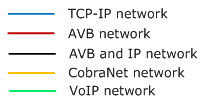
VoIP Telephony
Tesira offers several VoIP interface options: SVC-2 for the Server and Server-IO, TesiraFORTÉ VI, and TesiraFORTÉ VT.


